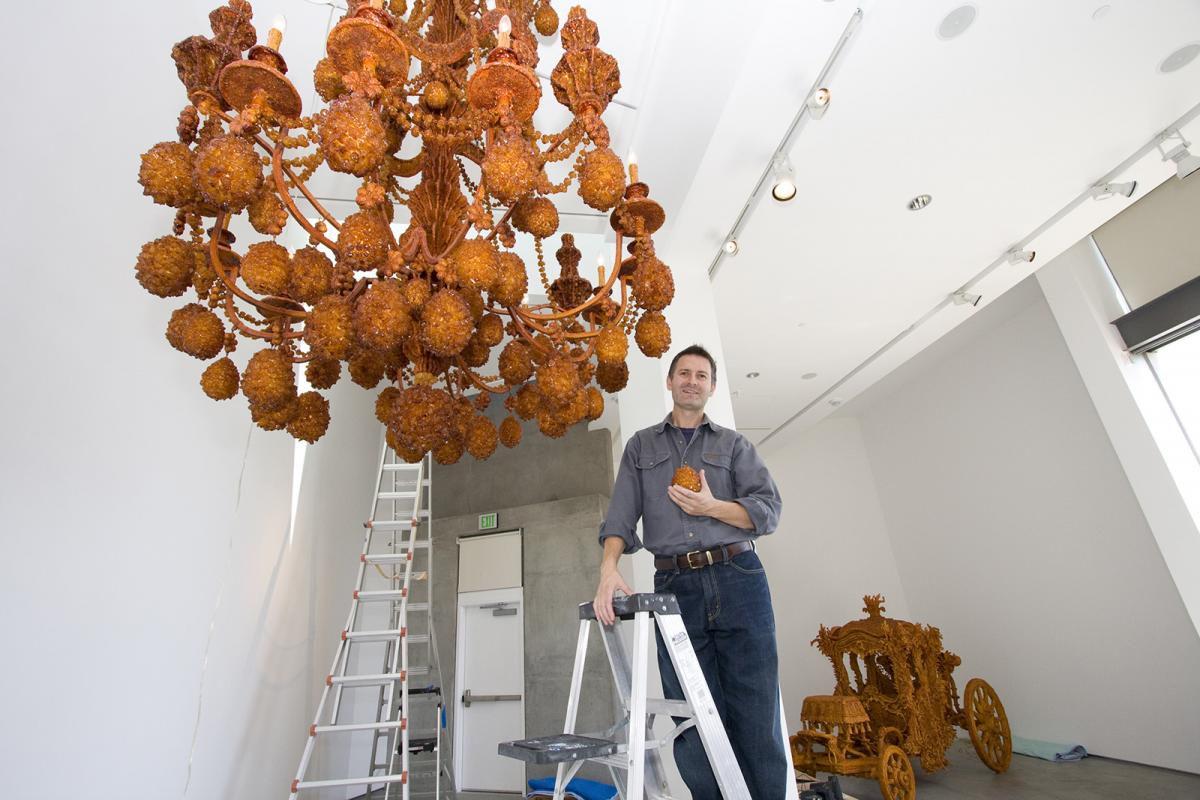Timothy Horn (b. 1964, resides Provincetown, Massachusetts) creates exaggerated adornments that combine natural and constructed worlds, taking inspiration from objects as varied as seventeenth-century jewelry patterns and nineteenth-century studies of lichen, coral, and seaweed. He works with traditional materials, such as bronze and glass, as well as surprising ones, like crystalized rock sugar, which refers to the extravagant Amber Room of Russian Empress Catherine the Great.
Timothy Horn’s wide-ranging work centers on dialogues between nature and culture. He draws inspiration from historical objects, narratives, and ways of making, including European decorative arts and baroque adornment. A native of Melbourne, Australia, Horn has lived and worked in the United States since 2002, when a scholarship brought him to the Massachusetts College of Art and Design. Trained in both sculpture and glassmaking, Horn has an uncanny ability to seize on the seductive qualities of his chosen materials.
The beauty in his work is made complex by his sense of the absurd and desire to create hybrid objects, infusing them with underlying narratives. His early work used decorative arts to play with notions of gender, sexuality, social structures, and power, and echoes of these themes reverberate through Horn’s more recent wall pieces. They speak not only to the inherent artistry and resilience of the natural world, but simultaneously remind us of our role in the fate of their existence. His dazzling constructions appear still, undisturbed and unaware of our presence, yet intent on continual, imperceptible growth.
Meet the Artist
Tree of Heaven 7
Horn’s Tree of Heaven series is titled after the common name of Ailanthus altissima, a tree native to China with a long cultural history. The sculpture’s form, however, references the work of Ernst Haeckel (1834–1919), a German zoologist, naturalist, and philosopher whose illustrated book Kunstformen der natur (Art Forms of Nature) is a regular source of inspiration for Horn. Echoing Haeckel’s images of lichens, Tree of Heaven 7 has tiny branches and flat leaf-like structures arranged in bursting rosettes, adorned with opulent blown glass “pearls,” that spreads like a living creature across the wall.
Mother-Load
Mother-Load is part of a suite of works Horn created in response to the rags-to-riches life story of San Francisco art collector Alma de Bretteville Spreckels (1881–1968), whose fortune stemmed from the sugar trade. This half-scale carriage, inspired by the Neapolitan sedan chair Alma used as a telephone booth, is covered with rock sugar that has been “refined” into encrusting crystals, tendril-like scrollwork, and attenuated stalactites. The inherent brittleness of sugar speaks to human fragility—just as the carriage would fall to pieces at the first bump in the road so can people easily fall from power.
Loaded with metaphor, the carriage’s color, luminousity, and opulence recall the Amber Room of Catherine Palace in Saint Petersburg, the lost “eighth wonder of the world,” where nature was displayed as commodity. This complex work also brings to mind capitalist society’s dependence on the mining of natural resources.
Courtesy of the artist
Girandole (Rain of Hot Stones)
The term girandole refers to a form of ornamental branched candlestick or light fixture that resembles a chandelier as well as the popular eighteenth-century jewelry form that features a large central design surrounded by smaller stones. As with Mother-Load, Horn hand-molded this exaggerated, sculptural form not from precious metals and gems, but from sugar. Through its fantastical scale and unconventional material, Girandole (Rain of Hot Stones) conjures a dreamy, yet slightly foreboding, fairy-tale atmosphere.
Courtesy of the artist
Gorgonia 12
The works in Horn’s Gorgonia series, named for a genus of soft corals, combine oceanic forms with designs for earrings and pendants from the seventeenth and eighteenth centuries. Horn begins by drafting a pattern inspired by the silhouette of a historical piece of adornment, then overlays decorative elements from the natural world onto that base. Translated into wax, cast in bronze, and dotted with blown glass “pearls,” each sculpture hangs just far away enough from the wall to create evocative shadows that suggest the watery deep. Horn’s desire to create beauty by melding nature and culture, however, is complicated: other titles in this series, such as Gorgonia 4 (Fukushima Fan Dance) and Gorgonia 7 (Sea Change), evoke human-induced disasters and the changing climate.































